Neutron Applications/ESS Bilbao
1. Introduction
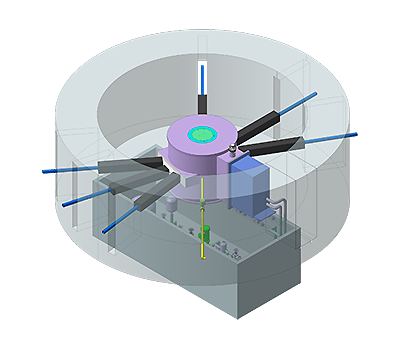
Figure 1: The ESS-Bilbao Target Station
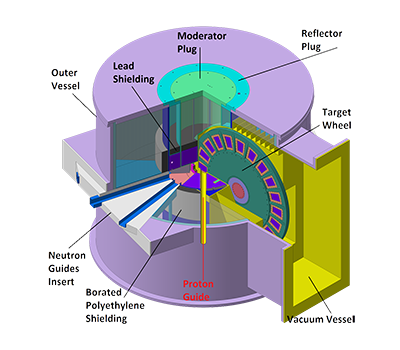
Figure 2: The ESS-Bilbao Target Station
2. Work Areas
In this context, the Target Station Division performs most of the tasks related to the stripping target and associated systems. This is a heavily multi-disciplinar work, involving well-de ned but interconnected elds. The Target Station Division is composed by the Neutronic Group and the Thermomechanical Analysis group. Besides, the Target Station Division is also responsible for a signi cant part of the collaboration with the ESS project, and some auxiliary work for the ESS-Bilbao A brief review of the work performed by this work is presented next.
2.1. Neutronics
The Neutronic Group uses MCNPX to evaluate neutronic performance, fed by a home-brewed code that generates input les acording to geometrical and composition parameters. Using this code, optimal con gurations can be found for the target station performance, and the e ects of a number of changes, such as adding an aditional moderator or a Be lter, can be explored for any Also, time and energy distribution are analyzed for the resulting neutron pulse, and the group have developed metrics in order to assess the shape of the neutron pulse.
This tool and techniques have also been used in the colaboration with the ESS project, where ESS-Bilbao has played a signi cant role in the neutronic calculations performed for Work Package 2 and 13. [9]
The group has also started performing coherent neutron transport calculation for cold neutron guides using McStas, and also conceptual design of neutron scattering instruments. These ca- pabilities are constantly being increased, and are expected to be of great importance for the ESS-Bilbao project. Besides, the Neutronic Group also performs dose and activation asses- ment, and proposes the radiological shielding, waste management, and maintenance options in accordance.
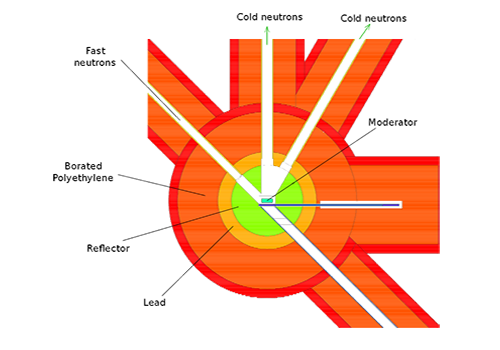
Figure 3: Neutronic model for the ESS-Bilbao Target Station
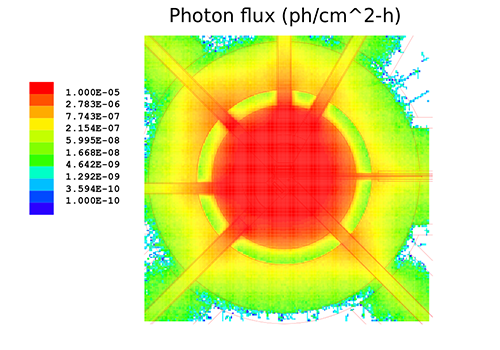
Figure 4: Photon flux in the target station
Basic irradiation damage calculations are also performed for the ESS-Bilbao project, as Hydro- gen implantation and He generation have been calculated, with the target expected to last 4 to 5 years thanks to the operating experience acquired in LENS facility [10] being incorporated in the design of the target.
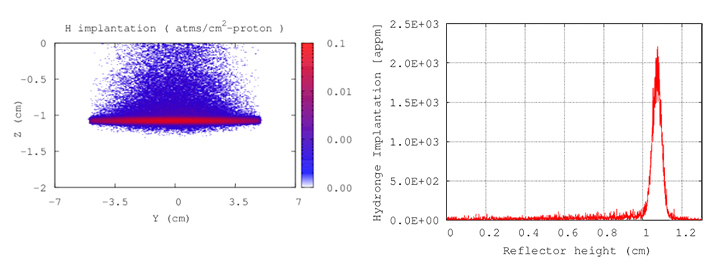
Figure 5: H implantation in the Be target
2.1 Thermomechanics
The Target Division has performed a large amount of thermomechanical calculations for the target station, among which the target cooling and stress analysis is an excelent example. Using ANSYS Workbench ™ as well as homebrew C-code to couple MCNPX heat calculations with CFD and mechanical analysis code, the Thermomechanics group has performed stress and deformation analysis which includes both mechanical and time-dependant thermal heat loads. [11]

Figure 6: Deformation in a part of the target
Another calculations performed by the Thermomechanical group is the Design of the ESS-Bilbao Beam Dump, an element designed to stop the protons during accelerator tests. Because of the high energy density of said beam, the beam dump has rather heavy requirements, requiring careful design. Starting with the GANIL Beam Dump design, and using both the results of their calculations as well as feedback from manufacturing companies, the Target Station Division has developed this concept into a design ready to be prototyped.
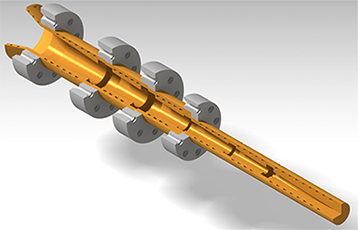
Figure 7: Beam Dump initial model
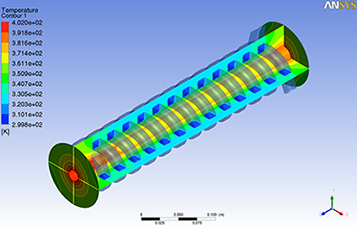
Figure 8: Thermal calculation of a segment of the ESS-Bilbao Beam Dump
The requirements of this element are working under an array of different beam conditions, which, thanks to the MCNPX-Ansys coupling, can be simulated with a high degree of automation, allowing batch calculation of the design and post-processing of the results.
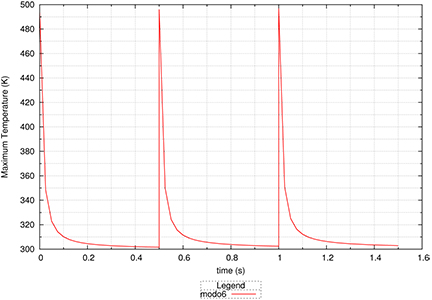
Figure 9: Time dependant max temperature for mode 6 operation of the ESS Beam Dump
Aditionally, the expertise of the Target station division is used to support other groups of the project for delicate cooling systems, such as the Beam Accelerator Radiofrequency Quadrupole (RFQ), which requires very strict deformation in order to work as intended, as even tiny de- formations result in changes of its inherent EM frequency. The calculations of such cooling require results from electromagnetics simulations, outside the eld of the Target Station group. However, colaboration with the Accelerator Division resulted in the development of a method to couple of the mechanical and electromagnetics simulations, allowing the frequency change to be calculated for di erent conditions. The Technical Design Report of this RFQ is soon to be released, and the cold model has already been built, with manufacturing tests ongoing.
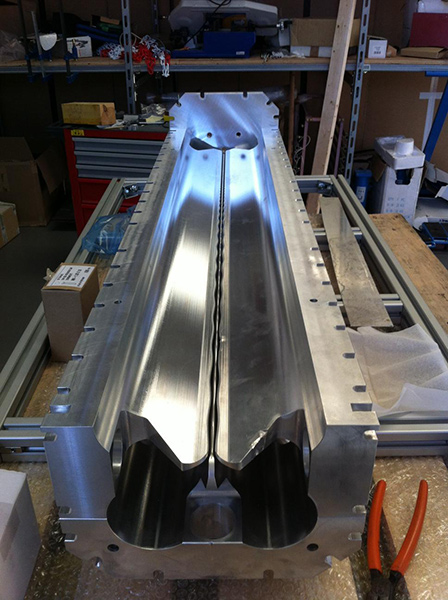
Figure 10: RFQ cold model
2.3. Technical Design Report of the Target Station
The Target Station Division is a goal-oriented team, and aims at practical, feasable imple- mentations of the concepts developed, and is constantly looking for references and worldwide experience. With this mindset, an international Technical Advisor Committee composed by experts from reference neutron production facilities like ISIS, PSI, CNEA and SNS, as well as the FZJ and UPM, was summonned in Madrid, in May 2013, in order to review the Technical Design Report of the Target Station. The reception was very positive, with the Committee apreciating the amount and quality of work done, and providing many useful advices and com- mentaries.
Bibliography
[1] M. Eshraqi, M. Brandin, I. Bustinduy, C. Carlile, H. Hahn, M. Lindroos, C. Oyon, S. Peggs, A. Ponton, K. Rathsman, et al., Conceptual design of the ess linac, IPAC10, 2001.
[2] M. Lindroos, et all The european spallation source, Nuclear Instruments and Methods in Physics Research Section B: Beam Interactions with Materials and Atoms, vol. 269, no. 24,pp. 3258 – 3260, 2011. Proceedings of the 10th European Conference on Accelerators in Applied Research and Technology (ECAART10).
[3] IAEA-TECDOC-1439, Development opportunities for small and medium scale accelerator driven neutron sources, tech. rep., 2005.
[4] V. Report of the 2nd Research Coordination Meeting, IAEA, Working paper on : Im- proved production and utilization of short pulsed, cold neutrons at low-medium energy spallation neutron sources, tech. rep.
[5] Y. Kiyanagi, N.Watanabe, and M. Nakajima, Neutronic studies on ux-trap moderators in spallation neutron sources, Nuclear Instruments and Methods in Physics Research Section A: Accelerators, Spectrometers, Detectors and Associated Equipment, vol. 343, no. 2a3,pp. 550a557, 1994.
[6] Y. Kiyanagi, Experimental studies on neutronic performance of various cold-neutron mod- erators for the pulsed neutron sources, Nuclear Instruments and Methods in Physics Re- search Section A: Accelerators, Spectrometers, Detectors and Associated Equipment, vol. 562, no. 2, pp. 561a564, 2006.
[7] Y. Kiyanagi, N. Watanabe, and H. Iwasa, Experimental studies on neutronic performance of coupled liquid-hydrogen moderator for pulsed spallation neutron sources, Nuclear Instru- ments and Methods in Physics Research Section A: Accelerators, Spectrometers, Detectors and Associated Equipment, vol. 312, no. 3, pp. 561a570, 1992.
[8] D. V. Baxter, S. Ansell, P. Ferguson, F. Gallmeier, E. Iverson, H. Kaiser, W. Lu, G. Muhrer,T. Rinckel, and T. Steinbach, Moderators at LENS: Performance and Development Research, Physics Procedia, vol. 26, no. 0, pp. 153a160, 2012. Proceedings of the first two meetings of the Union of Compact Accelerator-Driven Neutron Sources.
[9] M. Magan, et al., Nuclear Instruments & Methods In Physics Research A (2012), http://dx.doi.org/10.1016/j.nima.2012.03.036
[10] T. Rinckel and P. E. Sokol, Target Failure Report. LENS Internal Report , 2006.
[11] S. Terron, et al., Nuclear Instruments & Methods in Physics Research A (2013), http://dx.doi.org/10.1016/j.nima.2013.04.072
